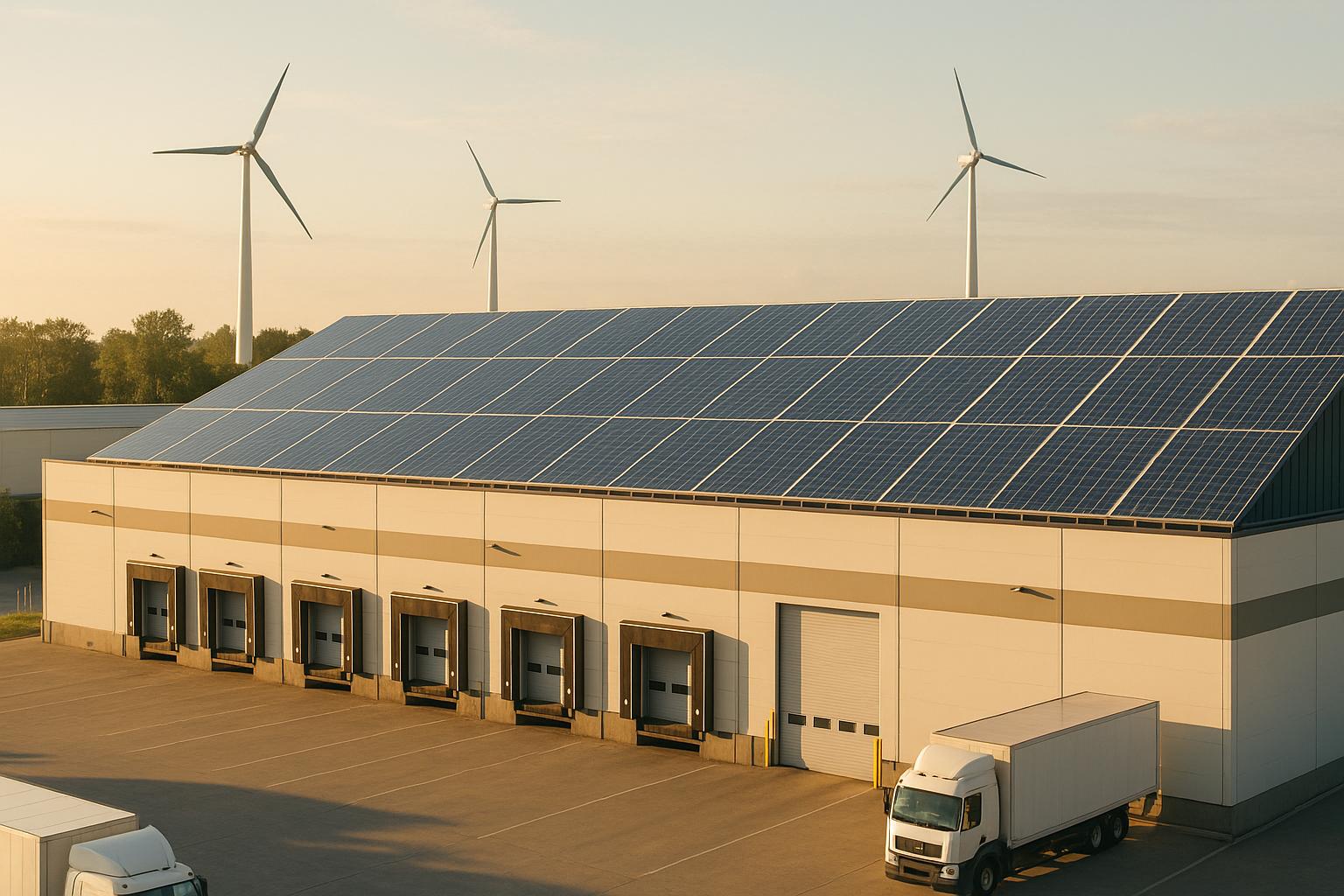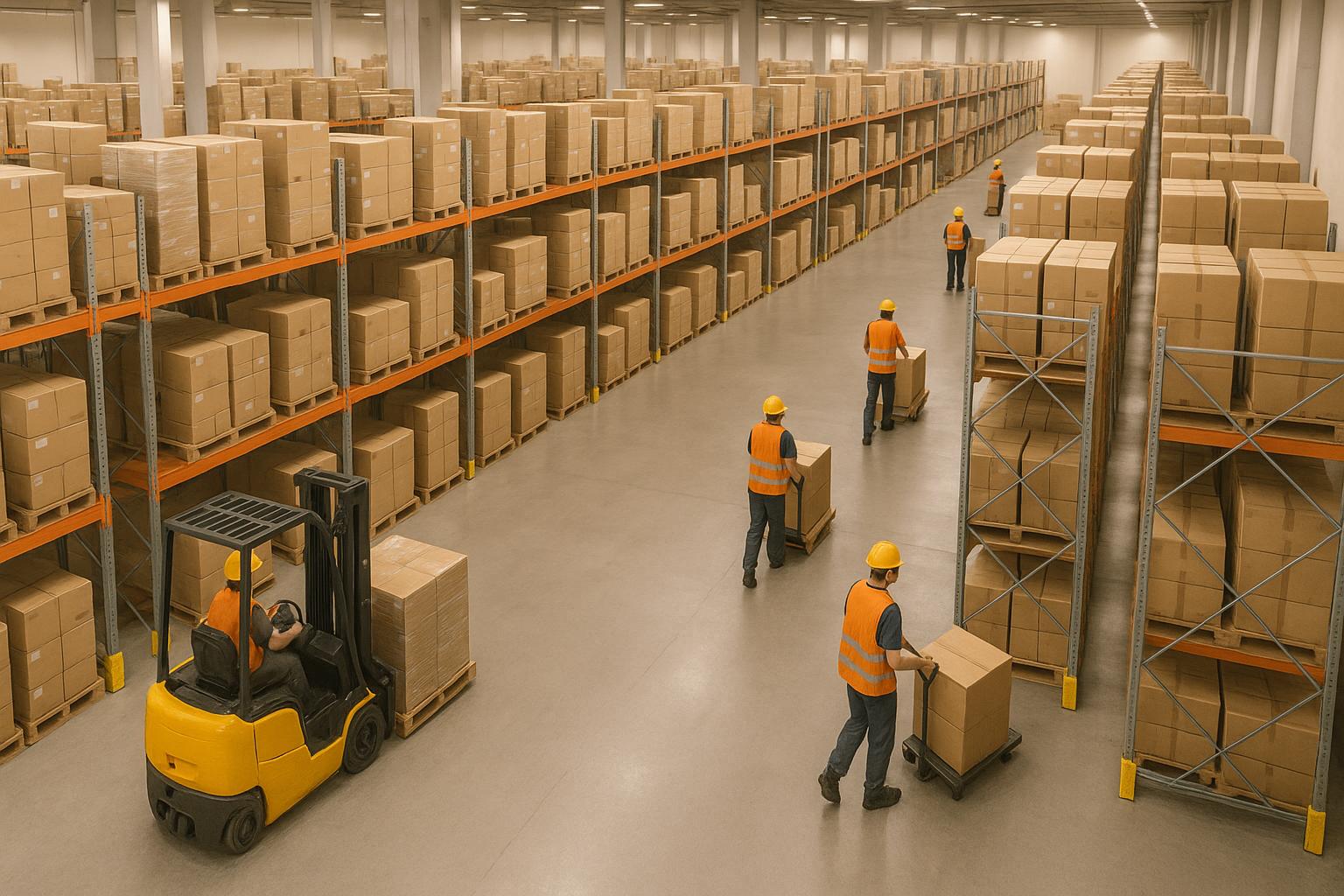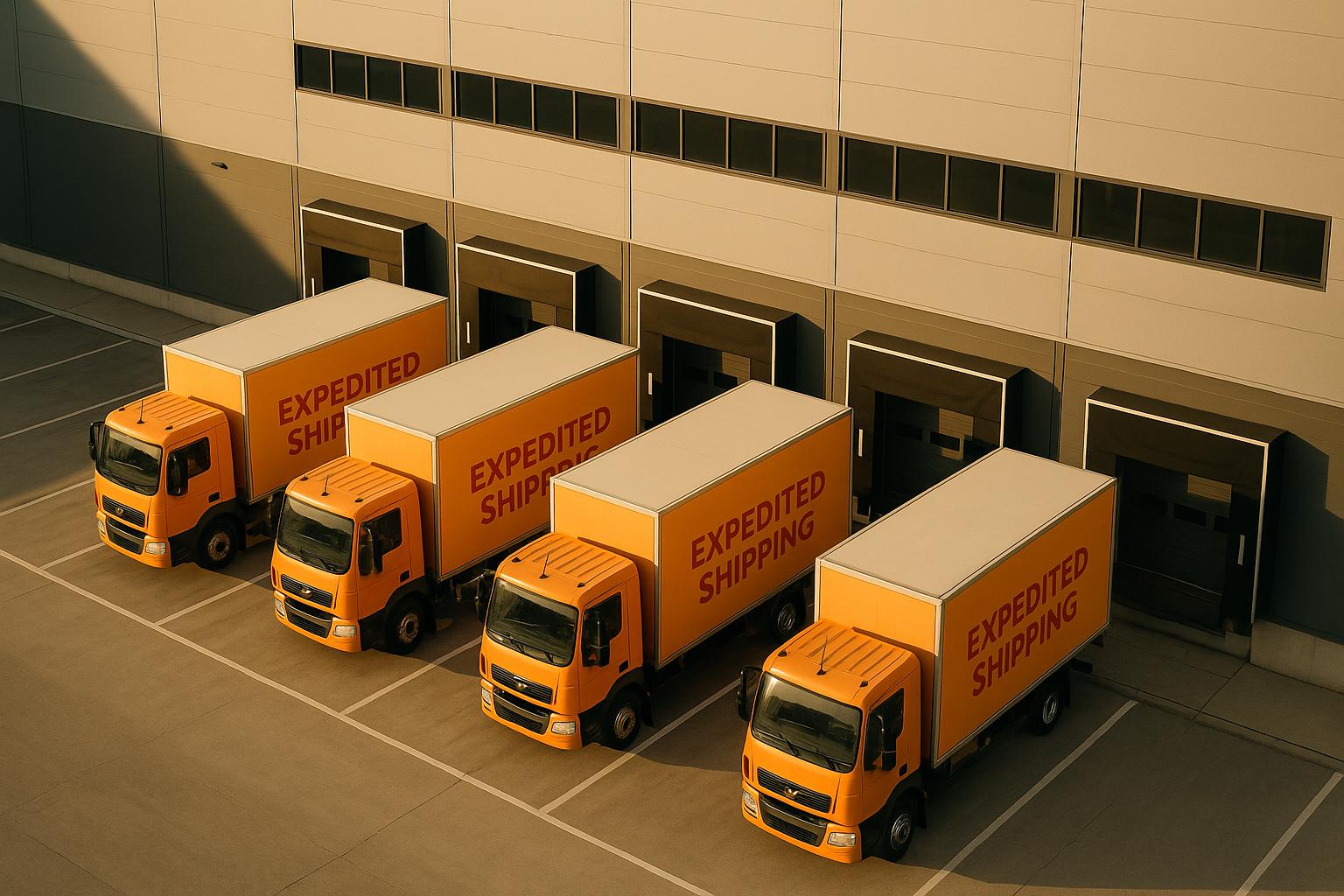Best Practices for Renewable Energy in 3PL Operations

Renewable energy is transforming 3PL operations by cutting costs, meeting regulations, and reducing reliance on fossil fuels. Key strategies include solar power for warehouses, electric fleets for transportation, and energy-efficient upgrades like LED lighting and smart HVAC systems. These methods not only save energy but also attract clients by aligning with sustainability goals.
Key Takeaways:
- Warehouse Solutions: Solar panels can offset up to 75% of energy needs; LED lighting and smart HVAC systems reduce energy use by 40–75%.
- Transportation: Electric vehicles and route optimization software lower emissions and fuel costs.
- Certifications: Programs like LEED, ISO 14001, and EPA SmartWay validate green energy efforts.
- Financial Benefits: Government incentives and energy savings often offset upfront costs within 5–10 years.
The bottom line: Investing in renewable energy boosts efficiency and positions 3PL providers to meet rising demand for cleaner supply chains.
Green Logistics-how sustainable practices can elevate your business | Daily Logistics
Warehouse Energy Solutions: Solar and Other Options
Upgrading warehouse energy systems plays a major role in advancing renewable energy efforts within 3PL operations. Warehouses consume large amounts of energy for lighting, climate control, and equipment. However, they also offer excellent opportunities to incorporate renewable energy solutions like solar power, which can be both cost-effective and environmentally friendly.
Solar Power for Warehouses
Rooftop solar panels are a cornerstone of energy strategies for warehouses across the United States. These systems can offset as much as 75% of a warehouse’s annual energy needs, cutting both operating costs and environmental impact. For instance, in 2023, a major 3PL provider in California installed a 1.2 MW rooftop solar system at one of its distribution centers. This project offset around 70% of the facility’s yearly energy consumption and saved over $150,000 annually on electricity bills.
The financial benefits of solar are hard to ignore. Commercial solar panel installations typically cost between $2.50 and $3.50 per watt. For warehouses, this translates to total installation costs ranging from $100,000 to $500,000, depending on size and location. While the upfront investment is significant, the return on investment usually comes within 5 to 8 years, thanks to energy savings and incentives that can offset 20–40% of the costs.
For warehouses unable to install rooftop solar - whether due to leasing arrangements, structural issues, or unsuitable roof conditions - community solar programs are a practical alternative. These programs allow businesses to purchase or subscribe to a share of a larger, off-site solar project. In return, they receive credits on their utility bills for the energy generated. This approach enables warehouses without direct solar installations to still benefit from renewable energy without the need for infrastructure investments. Combining solar with other renewable sources can further improve energy efficiency.
Wind, Geothermal, and Battery Storage
While solar power leads the way, many warehouses are adopting hybrid energy solutions that combine multiple renewable sources. Wind energy is an excellent option for facilities in regions with steady wind patterns, though it requires more space and specific geographic conditions to be effective.
Geothermal energy is another promising solution, particularly for climate control in warehouses. Ground-source heat pumps provide efficient heating and cooling, making them ideal for areas with extreme temperature swings. These systems deliver reliable performance throughout the year.
Battery storage is becoming a game-changer for optimizing energy use. The California 3PL provider mentioned earlier took their solar system a step further by adding battery storage and smart energy management tools. These systems store excess energy generated during peak sunlight hours, helping to reduce peak demand charges and enabling net-positive energy usage. The push toward net-positive energy facilities - where warehouses produce more energy than they consume - is gaining momentum as more 3PL providers integrate solar, battery storage, and demand-response systems.
Energy-Efficient Building Design
Combining renewable energy systems with smart building design can maximize energy savings. Simple upgrades to reduce overall energy demand not only enhance the performance of renewable systems but also offer quick returns on investment.
One effective upgrade is switching to LED lighting, which can cut energy use by up to 75%. LED retrofits typically cost between $1.50 and $3.00 per square foot, with payback periods of just 2 to 4 years.
Smart HVAC systems, when paired with improved insulation, can reduce warehouse energy consumption by 15–30%. These systems use advanced sensors and automation to optimize heating and cooling based on factors like occupancy, weather, and operational schedules. By predicting energy needs, they also help avoid costly peak demand charges.
| Solution | Typical Energy Savings | Average Cost (per sq ft) | Payback Period |
|---|---|---|---|
| Rooftop Solar | Up to 75% | $2.50–$3.50 per watt | 5–10 years |
| LED Lighting | Up to 75% | $1.50–$3.00 | 2–4 years |
| Smart HVAC | 15–30% | $2.00–$5.00 | 3–7 years |
| Improved Insulation | 15–30% | $1.00–$2.50 | 3–6 years |
Efforts to meet green building certifications, such as LEED or ENERGY STAR, are driving more warehouses to adopt comprehensive energy-efficient practices. These certifications not only reflect a commitment to sustainability but can also open the door to additional financing options and tax incentives, making these projects even more financially appealing.
To truly transform warehouse energy systems, a holistic approach is essential. Leading 3PL providers are combining solar power, energy storage, efficient building designs, and smart controls into strategies that deliver both environmental and financial benefits. By doing so, they are setting a new standard for sustainable logistics operations.
Clean Transportation: Electric Fleets and Fuel Efficiency
Transportation is a major area where 3PL providers can integrate renewable energy solutions. Since freight movement contributes significantly to logistics emissions, transitioning to electric fleets and improving fuel efficiency are key steps in reducing the environmental impact. These efforts are reshaping fleet operations and route planning.
Electric and Hybrid Vehicle Fleets
Fully electric vehicles produce zero tailpipe emissions when powered by renewable energy, making them a natural fit for clean transportation initiatives. They’re especially effective for urban and last-mile deliveries, where shorter distances and predictable charging schedules help cut operating costs and reduce maintenance needs. Additionally, optimized route planning can enhance the efficiency of these fleets even further.
For regional routes, hybrid vehicles offer a practical alternative. By combining an internal combustion engine with an electric motor, hybrids help lower fuel consumption and emissions while maintaining the flexibility needed for longer trips.
Smarter Route Planning to Cut Fuel Use
Beyond investing in cleaner vehicles, route optimization software plays a crucial role in reducing fuel use. These systems analyze factors like traffic patterns, delivery schedules, vehicle capacity, and fuel efficiency to design routes that minimize driving distances and fuel consumption. Using real-time data and insights into vehicle performance and driver behavior, modern routing tools can cut fuel usage by 15–25% - all without requiring expensive vehicle upgrades or infrastructure changes.
Another effective strategy is the hub-and-spoke model. By consolidating shipments at regional distribution centers, 3PL providers can use larger, more fuel-efficient vehicles for long-haul routes and rely on smaller electric or hybrid vehicles for the final leg of delivery.
Biofuels and Alternative Fuels
When full fleet electrification isn’t an option, biofuels and alternative fuels provide valuable transitional solutions. Depending on the type, biofuels can reduce lifecycle emissions by as much as 80% compared to traditional diesel. Renewable diesel, for example, can replace conventional diesel without requiring engine modifications, allowing fleets to lower their carbon footprint while maintaining operational consistency.
Compressed natural gas (CNG) is another option, particularly for heavy-duty vehicles. Meanwhile, hydrogen fuel cells are emerging as a promising solution for long-haul trucking, offering zero emissions and refueling times comparable to diesel.
To maximize the impact of these efforts, securing a steady fuel supply and achieving SmartWay certification can validate improvements in emissions and fuel efficiency.
Tracking the success of clean transportation strategies involves closely monitoring metrics like fuel consumption, greenhouse gas emissions per mile, and cost savings from efficiency improvements. Advanced monitoring systems with real-time dashboards can pinpoint further opportunities for optimization and demonstrate progress toward sustainability goals.
sbb-itb-eafa320
Tracking and Certifying Green Energy Use
Effectively tracking renewable energy usage requires solid systems and independent certifications to confirm environmental performance. Without third-party verification, 3PL providers face challenges in proving their environmental contributions. Trusted certifications combined with reliable monitoring tools ensure transparency and drive consistent progress. This level of oversight promotes better practices across warehousing, transportation, and overall operations.
Green Energy Certifications
Certifications play a critical role in validating sustainability efforts. Here are three key programs that set the benchmark for green energy use:
- LEED (Leadership in Energy and Environmental Design): Widely regarded as the premier standard for sustainable building practices in the U.S., LEED certification ensures warehouse facilities meet strict criteria for energy efficiency, water conservation, and indoor air quality.
- ISO 14001: This certification focuses on creating comprehensive environmental management systems, helping 3PL providers monitor their environmental impact, set sustainability goals, and implement structured improvements across their operations.
- EPA SmartWay: Designed to address transportation emissions and fuel efficiency, this program verifies compliance with rigorous fleet performance and environmental reporting standards. It also connects participants to a network dedicated to lowering freight-related emissions.
These certifications not only validate sustainability initiatives but also encourage operational enhancements, such as reduced energy costs and emissions. They provide third-party assurance that sustainability claims are credible.
At JIT Transportation, we integrate ISO 14001 and LEED certifications while actively participating in the EPA SmartWay program to reinforce our commitment to sustainable practices.
Energy Monitoring and Reporting Systems
Certifications are just one piece of the puzzle - ongoing monitoring is equally essential to ensure green initiatives stay on track. Modern energy monitoring systems offer real-time insights into renewable energy usage and overall environmental performance. These systems track key metrics like energy consumption, the percentage of renewable energy used, greenhouse gas emissions, and efficiency improvements. This data is collected at both the facility and fleet levels, meeting the reporting requirements of certification bodies.
Advanced dashboards make it easier to manage multiple sustainability metrics in one place. At JIT Transportation, our cutting-edge dashboards provide real-time updates on emissions, energy savings, and operational efficiency. These tools help us maintain transparency and work toward measurable sustainability goals.
How to Implement Renewable Energy in 3PL Operations
Incorporating renewable energy into third-party logistics (3PL) operations requires a well-thought-out strategy that tackles technical, financial, and operational hurdles. The process unfolds in several stages, each building on the last to create a solid approach to sustainability.
Energy Audits and Assessment
Start by conducting a thorough energy audit to understand your current energy usage. This step helps pinpoint areas where renewable energy can make the biggest impact.
Take a close look at your warehouses, focusing on lighting, HVAC systems, and equipment energy consumption. For example, switching to LED lighting can slash energy use by up to 75%, while also cutting down on maintenance costs and extending the lifespan of your lighting systems.
Next, analyze your transportation fleet. Track fuel consumption across routes, identify peak usage times, and assess vehicle performance under different conditions. This data is crucial for planning a shift to electric or hybrid vehicles.
Make sure to record baseline energy and fuel consumption data. This provides a starting point for setting realistic improvement goals. Don’t forget to account for seasonal changes, like increased heating or cooling costs in warehouses or fluctuating fuel needs, to ensure your renewable energy solutions can handle peak demands.
Working with Partners and Energy Providers
Collaborating with energy providers and technology experts can speed up the adoption of renewable energy while reducing technical risks. Look into local utility companies that offer renewable energy programs. Many provide rebates, tax incentives, or power purchase agreements (PPAs) to help offset initial costs.
Partner with contractors who specialize in renewable energy installations for commercial and industrial operations. Choose those with proven success in logistics settings, and always check references or visit completed projects to ensure they align with your operational needs.
PPAs are a great option for managing costs. Under these agreements, providers install and maintain renewable energy systems - like solar panels - at little to no upfront cost. You simply pay for the energy generated at a fixed rate.
While challenges like high upfront costs, technical complexity, and resistance to change are common, they can be addressed. Leverage government incentives, work with experienced energy providers, and invest in employee training to build expertise and secure buy-in from both leadership and staff.
To stay on track, set clear timelines and milestones with your partners. With a strong collaboration strategy in place, you can focus on achieving measurable outcomes.
Transparent Reporting and Measurable Results
Once audits are complete and partnerships are established, it’s time to measure and report your progress. Transparent reporting is essential for showcasing the environmental and business impact of your renewable energy initiatives.
Define key performance indicators (KPIs) that align with your sustainability goals. Metrics like renewable energy usage, greenhouse gas (GHG) reductions, and cost savings are practical benchmarks. Set achievable targets with realistic timelines to ensure your efforts stay aligned with both environmental and business objectives.
Real-time monitoring systems can provide ongoing visibility into your renewable energy performance. Dashboards that update continuously allow you to track progress and identify areas for improvement. This transparency not only builds trust with clients and stakeholders but also helps fine-tune your sustainability initiatives.
Establish a regular reporting schedule. Monthly internal reports can quickly highlight operational issues, while quarterly updates demonstrate steady progress. Annual sustainability reports provide a comprehensive overview that supports marketing efforts and strengthens client relationships.
Finally, document both the cost savings and environmental benefits of your renewable energy investments. Track avoided utility costs, fuel savings, and any revenue from selling excess solar power back to the grid. This data underscores the long-term value of renewable energy and helps justify future expansions.
Conclusion: Building a Greener Future for 3PL Operations
Renewable energy offers a powerful edge for 3PL operations. Companies adopting solar power, electric fleets, and energy-efficient building designs are already seeing impressive returns while meeting the rising demand for eco-friendly supply chain solutions. These early successes highlight the potential for both operational improvements and environmental gains.
For example, in 2022, one provider reduced warehouse energy consumption by more than 60% by combining solar power, LED lighting, smart HVAC systems, and a shift to electric vehicles.
Programs like SmartWay, ISO 14001, and LEED are becoming essential for earning certifications that validate sustainability efforts and build client trust. Transparency in these initiatives strengthens relationships and demonstrates accountability.
The financial upsides go beyond energy savings. Implementing green packaging and waste reduction strategies can cut material use and shipping costs. Some 3PLs have reported double-digit reductions in waste, showcasing the value of ongoing monitoring and process optimization.
The shift toward renewable energy in 3PL facilities is gaining momentum, driven by cost savings and sustainability goals. Electric and hybrid vehicle fleets are now common for urban and regional deliveries, while biofuels support long-haul routes. These investments prepare the logistics sector for the future, creating a more adaptable and efficient system.
By integrating renewable energy strategies and pursuing measurable certifications, 3PL providers can track their progress, maintain transparency, and clearly demonstrate their environmental contributions. This approach not only enhances operational performance but also supports sustainable growth, benefiting both businesses and the planet.
At JIT Transportation, we are committed to implementing these renewable strategies to improve efficiency and help create a greener future.
FAQs
What strategies can 3PL providers use to manage the high upfront costs of adopting renewable energy solutions?
3PL providers can tackle the steep initial costs of renewable energy by taking advantage of financial incentives like tax credits, grants, and subsidies available through federal and state programs. These incentives can help cut down the upfront investment, making renewable energy more accessible.
Another smart strategy is to roll out renewable energy projects in phases. For instance, starting with smaller, scalable initiatives - such as installing solar panels on key facilities - can minimize financial risks while still generating noticeable savings over time.
Leasing renewable energy systems or teaming up with energy providers is another way to manage costs. This approach allows 3PL companies to tap into cleaner energy sources without needing to commit to full ownership right away.
How can certifications like LEED and ISO 14001 benefit 3PL operations that use renewable energy?
Certifications such as LEED (Leadership in Energy and Environmental Design) and ISO 14001 can bring valuable benefits to 3PL operations that integrate renewable energy. They signal a strong dedication to sustainability, boosting your company's image and making it more attractive to environmentally conscious clients.
Beyond reputation, these certifications encourage energy-efficient practices and waste reduction, which can streamline operations. They may also unlock financial perks like tax breaks, energy credits, or long-term savings on operational costs. By earning these certifications, your business can stand out as a forward-thinking leader in sustainable logistics, giving you an edge in a competitive industry.
How can warehouses benefit from community solar programs if rooftop solar panels aren't an option?
Community solar programs offer warehouses an easy way to tap into renewable energy - no on-site solar panels required. By subscribing to a shared solar farm, warehouses can offset their electricity use with clean energy. Plus, many programs include utility bill credits, which can help lower overall energy costs.
This approach works especially well for facilities where rooftop solar isn’t an option due to structural issues or limited space. It’s also a smart way for businesses to work toward their sustainability goals while contributing to the growth of renewable energy in their local areas.
Related Blog Posts
Related Articles

5 Replenishment Strategies for Omnichannel Fulfillment

Ultimate Guide to Expedited Shipping for E-Commerce

